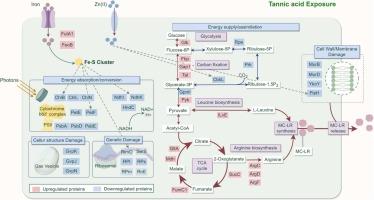单宁酸对铜绿微囊藻的长期抑制:微囊藻毒素污染风险及蛋白质组学机制
IF 11.3
1区 环境科学与生态学
Q1 ENGINEERING, ENVIRONMENTAL
引用次数: 0
摘要
有害藻华是严重影响水生生态系统和人类健康的重要生态环境问题。单宁酸(TA)被认为是一种有效的控制藻华的物质,但其与藻类细胞相互作用的分子机制及其对藻毒素释放的影响尚不清楚。本研究追踪了暴露于TA的产毒物种铜绿微囊藻(M. aeruginosa)的毒素产生和释放,通过蛋白质组学分析揭示了潜在的机制。高剂量TA能有效抑制M. aeruginosa的生长和微胱氨酸-亮氨酸-精氨酸(MC-LR)的产生。然而,在特定的TA浓度下,M. aeruginosa产生和释放更多的mc,细胞外MC-LR水平在第15天达到1.91倍的峰值。蛋白质组学分析显示,与三羧酸(TCA)循环、糖酵解、亮氨酸和精氨酸生物合成相关的蛋白质上调,表明铜绿假单胞菌在TA胁迫下存在代偿反应,增强了细胞能量供应和MC-LR的生物合成。此外,TA暴露显著下调了参与离子和金属簇结合的蛋白质,扰乱了电子转移和光合作用。本研究为揭示TA诱导的mc污染风险和TA抑制藻类的机制提供了新的思路,为TA在藻华控制中的应用提供了指导。本文章由计算机程序翻译,如有差异,请以英文原文为准。

Long-term suppression of Microcystis aeruginosa by tannic acid: Risks of microcystin pollution and proteomic mechanisms
Harmful algal blooms are a critical eco-environmental issue with severe impacts on aquatic ecosystems and human health. Tannic acid (TA) has been suggested as an effective algal bloom control, but the molecular mechanisms of its interaction with algae cells and its effects on algal toxin release remain unclear. This study tracked toxin production and release in the toxigenic species Microcystis aeruginosa (M. aeruginosa) exposed to TA, revealing underlying mechanisms through proteomic analysis. High TA doses effectively inhibited M. aeruginosa growth and microcystin-leucine-arginine (MC-LR) production. However, at a specific TA concentration, M. aeruginosa produced and released more MCs, with extracellular MC-LR levels peaking at 1.91 times the control on day 15. Proteomic analysis indicated upregulation of proteins related to the tricarboxylic acid (TCA) cycle, glycolysis, and leucine and arginine biosynthesis, suggesting a compensatory response in M. aeruginosa under TA stress that enhanced cellular energy supply and MC-LR biosynthesis. In addition, TA exposure significantly downregulated proteins involved in ion and metal-cluster binding, disrupting electron transfer and photosynthesis. This study provides new insights into TA-induced MC-pollution risks and TA’s mechanisms in algae suppression, offering guidance for its application in algal bloom control.
求助全文
通过发布文献求助,成功后即可免费获取论文全文。
去求助
来源期刊

Journal of Hazardous Materials
工程技术-工程:环境
CiteScore
25.40
自引率
5.90%
发文量
3059
审稿时长
58 days
期刊介绍:
The Journal of Hazardous Materials serves as a global platform for promoting cutting-edge research in the field of Environmental Science and Engineering. Our publication features a wide range of articles, including full-length research papers, review articles, and perspectives, with the aim of enhancing our understanding of the dangers and risks associated with various materials concerning public health and the environment. It is important to note that the term "environmental contaminants" refers specifically to substances that pose hazardous effects through contamination, while excluding those that do not have such impacts on the environment or human health. Moreover, we emphasize the distinction between wastes and hazardous materials in order to provide further clarity on the scope of the journal. We have a keen interest in exploring specific compounds and microbial agents that have adverse effects on the environment.
 求助内容:
求助内容: 应助结果提醒方式:
应助结果提醒方式:


